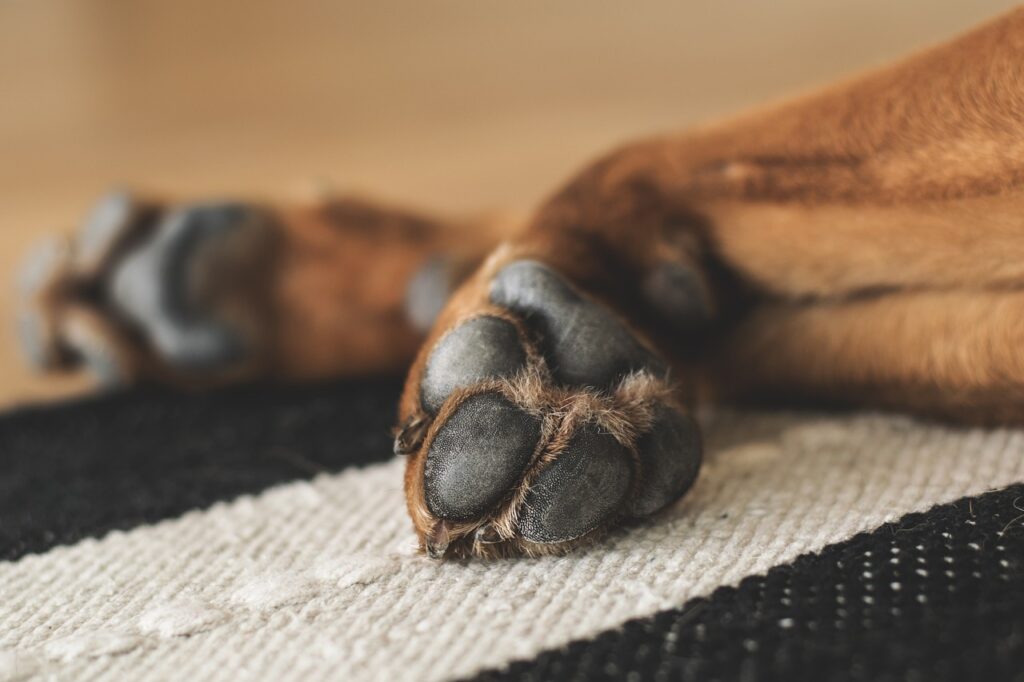Ready for some paw talk? It’s no secret that our four legged friends love to accompany us on various adventures. In this blog we’ll discuss the anatomy of the paw and how to take care of them.
Dog Paw Anatomy Basics
Dogs’ paws are remarkable structures that are well-designed for a wide range of activities, including running, jumping, digging, and even swimming. Each of these parts plays a specific role in providing support, traction, cushioning, and protection for the dog’s feet and legs. Understanding the anatomy and function of a dog’s paw is important for dog owners and veterinarians alike, as it can help identify potential problems and ensure that dogs remain healthy, active, and comfortable throughout their lives. Paws are made up of several different components:
A. Claws: Sharp, curved nails at the end of each toe. They are used for digging, grasping, and traction.
B. Digital Pads: The smaller, round pads located behind the larger main pad on each toe. They provide additional support and traction.
C. Metacarpal and Metatarsal Pads: The pads located higher up on the paw, just above the digital pads. They help distribute the dog’s weight and provide extra cushioning.
D. Dewclaw: These are the small, vestigial toes located higher up on the dog’s leg. Some breeds have dewclaws on their front and back legs, while others only have them on their front legs.
E. Carpal Pad: Provides extra cushioning and grip when the animal is walking or running on rough or uneven surfaces. It helps distribute the weight of the animal’s body and absorb shock, reducing the impact on the bones and joints in the front legs.

Your Dog’s Paw Health
Proper paw care is an essential part of maintaining a dog’s overall health and well-being. Dogs rely on their paws for a variety of activities, from walking and running to digging and exploring, making it important to keep them in good condition. Neglecting paw care can lead to discomfort, pain, and even infection.
Fortunately, there are several steps that dog owners can take to keep their furry friends’ paws healthy and happy. From regular grooming and cleaning to providing proper footwear and protecting against extreme temperatures and rough surfaces, this guide will cover everything you need to know about taking care of your dog’s paws. With the right care and attention, you can help ensure that your dog’s paws remain strong, healthy, and ready for whatever adventures lie ahead. Here are a couple ideas for keeping your pet’s paws healthy.
Dog Pedicures
Ideally, your dog’s nails should make only slight contact with the ground while walking, without producing loud clicking sounds. If you hear excessive clicking noises, it is an indication that it’s time to trim their nails. To do so, seek recommendations from your veterinarian or groomer on the most suitable nail trimmers to purchase and how to properly use them. Following their instructions can ensure that your dog’s nails are trimmed safely and comfortably.
Trimming the Paw Hair
Matted hair can be uncomfortable and painful for dogs. To avoid this, it’s important to comb the hair between their paw pads regularly and keep it trimmed evenly with the pads.
Clean Between the Paws
Regularly checking your dog’s digital pads is important as small objects such as pebbles or broken glass can get lodged in them. In such cases, it’s advisable to use tweezers to remove the foreign object. By being proactive and checking their pads, you can prevent discomfort and injury for your furry friend.
Prevent Cracking by Moisturizing their Pads
When choosing a moisturizer for your dog’s paw pads, it’s important to opt for products that are specifically formulated for dogs. Human moisturizers can soften the pads and cause injury. To ensure you choose the right product, consult with your veterinarian for recommendations on the best moisturizers.
Choose the Best Exercise Program
Dogs who have spent the majority of time living indoors may not have developed the tolerance to rough surfaces, extreme temperatures, and other outdoor conditions. It’s essential to start with short walks and gradually increase the distance.
If you want to introduce your indoor dog to more physical activity, it’s recommended to begin slowly and gradually increase the duration and intensity of their exercise routine. By taking these steps, you can help build up their endurance and reduce the risk of injury or discomfort.

